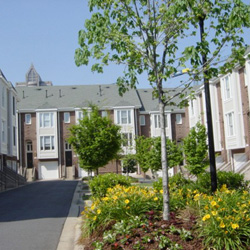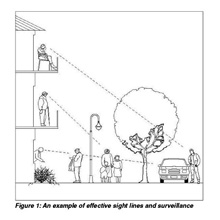 |
| CPTED focuses on designing crime prevention into buildings and campuses |
In recent years, jurisdictions across the United States have enacted ordinances or codes requiring the use of Crime Prevention Through Environmental Design (CPTED). Enforcement of these measures arises through required jurisdictional review and approval of CPTED measures in the design drawings.
CPTED has emerged in recent years as an effective crime prevention and security technique that focuses on designing crime prevention into buildings and campuses. Design principles include natural surveillance, which yields spaces that are designed so that users, inside and out, can easily see anyone who acts in an unusual way.
A second principle aims to create passive access control points through space design that directs people along certain paths and restricts them from following others.
Third, easily perceived space boundaries create a sense of territoriality.
Next comes design concepts that make buildings and their grounds easy to maintain. Well-maintained, high quality spaces attract authorised regular users while discouraging others.
CPTED design in general aims to make users comfortable inside and out while discouraging casual as well as more determined intruders —on the theory that criminals interested in misdemeanours or felonies will avoid spaces where they might be caught.
Depending upon the security needs of the space, security personnel and technology can be layered on top of CPTED features more readily than a building designed without regard to CPTED.
 See larger image |
| An example of effective sight lines and surveillance |
“For example, cameras, access control systems, door locks and alarms all need electricity,” says Randall I. Atlas, president of Fort Lauderdale, Fla.-based Atlas Security & Safety Design Inc. “To provide electricity, a design must include conduit runs to the areas of the building where the technology will be installed.”
But how do you know where the technology should be installed. Planning a CPTED for a building begins with something called problem seeking.
“Who are the tenants and visitors?” asks Atlas. “Where are the shipping and receiving areas? Where are the entrances? Where are the opportunities that might allow trespass? When do people park in the garage connected to the building?”
“This is problem seeking. In combination with the security assessment, problem seeking helps you determine appropriate security for the perimeter and interior of the building.”
Designing With CPTED
Atlas recommends integrating CPTED into designs for new construction, expansions or renovations.
Effective CPTED design begins at the beginning — during the programming phase of the project when the owner or property manager assembles a building team.
“If the owner-management has a security director, that person should participate in the programming phase,” says Atlas. “If there is no security director, the team should retain a security design and CPTED consultant.”
The security director or consultant will conduct a risk assessment and develop the criteria for the security programming and design, continues Atlas. If the jurisdiction has incorporated elements of CPTED into its building code, the criteria should include those requirements.
The architect can integrate the design criteria into the schematic design, construction documents and written specifications.
“Next, the security director or consultant must review the design to ensure that nothing has been overlooked and that it complies with the security criteria,” Atlas says. “Following review by the appropriate jurisdictional authorities, the drawings go out to the contractor.
“Specifically, they will address security lighting, access control, surveillance, door contacts, blind spots and entrapment areas. They will define public and private spaces with good boundaries and provide for appropriate lighting and landscaping.
“By following all of the building code requirements, including the CPTED requirements or recommendations, the final building will be less likely to be vulnerable to fire and weather disasters as well as workplace violence and opportunistic criminals.”
In the end, those are pretty good reasons to rent space in a particular building.
